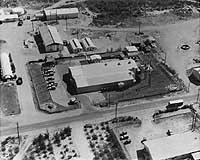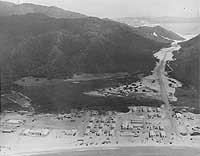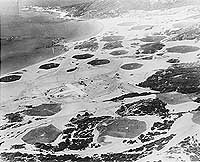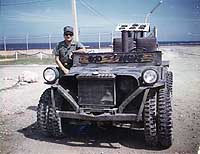Return to Naval History
and Heritage Command home page.  Return
to Online Library listing
Return
to Online Library listing

DEPARTMENT OF THE NAVY -- NAVAL HISTORY AND HERITAGE
COMMAND
805 KIDDER BREESE SE -- WASHINGTON NAVY YARD
WASHINGTON DC 20374-5060

Online Library of Selected Images:
-- PLACES -- ASIA -- VIETNAM
Naval Communication Station, Cam Ranh Bay, Republic of Vietnam
In its brief history (1967-1972) Naval Communication Station
Cam Ranh Bay performed an important function as a link in the
worldwide Naval Communication System and the Defense Communication
System. It supported all U.S. naval units in and adjacent to the
Republic of Vietnam, including major units of the Seventh Fleet.
Its complement of approximately 240 enlisted and 12 officers were
spread over three separate sites on the eastern and southern sides
of the Cam Ranh Bay penninsula. The communication center was a
tenant command of the Naval Support Facility on the southern coast.
The receiver and transmitter sites were located 3 and 6 miles,
respectively, up the eastern coast facing the South China Sea.
Personnel at the communication center assisted Naval Support
Facility personnel with security. However, at both the receiver
and transmitter sites security was the sole responsibility of
site personnel. They built and maintained bunkers and watch towers,
trained with small arms (including pistols, rifles, mortars and
.50 calibre machine guns) and patrolled their areas with self-assembled
dune buggies. Fortunately, the enemy was more interested in targeting
ammunition and fuel dumps located on the western side of the penninsula,
attacks on which made more newsworthy events. Thus, while security
was a constant worry, it was within the capability of site personnel.
The self-help program was not limited to security. Extensive use
of surplus material was used to improve operational, recreational
and liveability conditions. For example, surplus helicopter landing
pads were used to prevent erosion in the antenna fields. In addition,
recreation facilities and vastly improved barracks resulted from
imaginative use of surplus lumber and material.
After approximately 4 years of support to U.S. forces (1967-1972),
in early 1971 Naval Communication Station Cam Ranh Bay commenced
the process of turning the station over to the Vietnamese Navy.
From 1969 to 1971 station personnel had trained approximately
117 Vietnamese Navy communication officers and 68 teletype and
microwave repair enlisted men. In March 1971 approximately 60
Vietnamese enlisted men reported aboard to commence the turnover,
which was completed in early 1972.
Note: The above text was prepared by Captain William
J. Longhi, USN (Retired), who commanded Naval Communication Station,
Cam Ranh Bay from 3 August, 1970 to 14 June 1971.
This page features views concerning Naval Communication
Station, Cam Ranh Bay, Republic of Vietnam
For more pictures concerning this facility, see:
Captain William
J. Longhi Collection: Naval Communication Station Cam Ranh Bay,
Vietnam, photographs and memorabilia, 1970-1971.
Click on the small photograph to prompt
a larger view of the same image.
Photo #: NH 106463
Naval Communication Station, Cam Ranh Bay, Republic of Vietnam
View of the communications and relay center of the Naval Communication
Station, a tenant command of the Naval Support Facility Cam Ranh
Bay. The building in the foreground houses the commander and
staff of TF 115, the Coastal Surveillance Force.
Photographed circa 1970-1971.
Collection of Captain William J. Longhi, USN (Retired), 2009.
Official U.S. Navy Photograph, from the collections of the
Naval History and Heritage Command.
Online Image: 135KB; 900 x 745 pixels |
 |
Photo #: NH 106464
Naval Communication Station, Cam Ranh Bay, Republic of Vietnam
View of Naval Support Facility Cam Ranh Bay. Naval Communication
Station Cam Ranh Bay communication center is on the extreme left.
Photographed circa 1970-1971.
Collection of Captain William J. Longhi, USN (Retired), 2009.
Official U.S. Navy Photograph, from the collections of the
Naval History and Heritage Command.
Online Image: 96KB; 900 x 735 pixels |
 |
Photo #: NH 106465
Naval Communication Station, Cam Ranh Bay, Republic of Vietnam
The receiver site of Naval Communication Station Cam Ranh Bay
is in the center of the photo. The larger building to the left
houses the U.S. Air Force operated cable head for the underwater
communication cable from Nha Trang.
Photographed circa 1970-1971.
Collection of Captain William J. Longhi, USN (Retired), 2009.
Official U.S. Navy Photograph, from the collections of the
Naval History and Heritage Command.
Online Image: 92KB; 900 x 650 pixels |
 |
Photo #: NH 106466
Naval Communication Station, Cam Ranh Bay, Republic of Vietnam
View of Naval Communication Station Cam Ranh Bay transmitter
site under construction in 1967. Note that the security fence
has not yet been installed.
Collection of Captain William J. Longhi, USN (Retired), 2009.
Official U.S. Navy Photograph, from the collections of the
Naval History and Heritage Command.
Online Image: 123KB; 900 x 750 pixels |
 |
Photo #: NH 106467
Naval Communication Station, Cam Ranh Bay, Republic of Vietnam
View of the transmitter site of Naval Communication Station Cam
Ranh Bay in June 1967. The station was commisioned 1 August 1967.
Collection of Captain William J. Longhi, USN (Retired), 2009.
Official U.S. Navy Photograph, from the collections of the
Naval History and Heritage Command.
Online Image: 155KB; 900 x 750 pixels |
 |
Photo #: NH 106468
Naval Communication Station, Cam Ranh Bay, Republic of Vietnam
View of the transmitter site of Naval Communication Station Cam
Ranh Bay on the South China Sea. The transmitter site was located
approximately six miles north of the communication center.
Photographed circa 1970-1971.
Collection of Captain William J. Longhi, USN (Retired), 2009.
Official U.S. Navy Photograph, from the collections of the
Naval History and Heritage Command.
Online Image: 131KB; 900 x 750 pixels |
 |
Photo #: NH 106469-KN (color)
Naval Communication Station, Cam Ranh Bay, Republic of Vietnam
Commander William J. Longhi, Commanding Officer of Naval Communication
Station Cam Ranh Bay, alongside the dune buggy "Bad News".
Assembled by the Station's receiver site personnel, the buggy
was used to patrol the area around the receiver site.
Photographed circa 1970-1971.
Collection of Captain William J. Longhi, USN (Retired), 2009.
U.S. Naval History and Heritage Command.Photograph
Online Image: 98KB; 740 x 595 pixels |
 |
Photo #: NH 106470
Naval Communication Station, Cam Ranh Bay, Republic of Vietnam
RMCS Nicholas at the wheel of the dune buggy "Bad News",
armed with an M60 machine gun, patrolling the receiver site of
Naval Communication Station Cam Ranh Bay circa 1971.
Collection of Captain William J. Longhi, USN (Retired), 2009.
U.S. Naval History and Heritage Command.Photograph
Online Image: 72KB; 740 x 585 pixels |
 |
For more pictures concerning this facility, see:
Captain William
J. Longhi Collection: Naval Communication Station Cam Ranh Bay,
Vietnam, photographs and memorabilia, 1970-1971.
NOTES:
To the best of our knowledge, the pictures referenced here
are all in the Public Domain, and can therefore be freely downloaded
and used for any purpose.
Some images linked from this page may bear obsolete credit
lines citing the organization name: "Naval Historical Center".
Effective 1 December 2008 the name should be cited as: "Naval
History and Heritage Command".
 Return to Naval
History and Heritage Command home page.
Return to Naval
History and Heritage Command home page.
Page made 9 April 2009
Caption updated 5 May 2009
